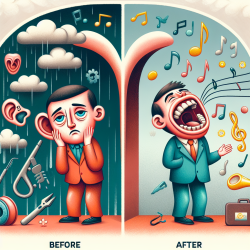Introduction
In the realm of orthodontics and speech therapy, practitioners continually seek methods to enhance patient outcomes. A recent multicentric randomized controlled trial titled "Effects of Maxillary Expansion on Hearing and Voice Function in Non-Cleft Lip Palate and Cleft Lip Palate Patients with Transverse Maxillary Deficiency" sheds light on a transformative approach. This study reveals the profound impact of rapid maxillary expansion (RME) on hearing and voice functions, offering new avenues for therapeutic interventions.
Understanding the Study
The study involved 53 patients, both non-cleft and bilateral cleft lip palate (BCLP), aged around 11 years. The participants underwent RME to correct narrow maxillary arches. The study meticulously measured hearing and voice parameters at various stages: before expansion (T0), after expansion (T1), three months post-expansion (T2), and at the end of the retention period (T3).
Key Findings
- Hearing Improvements: The study found significant improvements in hearing levels and middle ear volumes in non-cleft and BCLP patients with normal hearing and mild conductive hearing loss. These improvements were consistent across various observation periods, highlighting the potential of RME in enhancing auditory functions.
- Voice Function: In non-cleft patients, RME significantly influenced voice quality, particularly in terms of fundamental frequency and jitter percentage. However, these effects were not observed in BCLP patients, indicating a differential impact based on patient groups.
Implications for Practitioners
For practitioners in orthodontics and speech therapy, these findings underscore the importance of considering RME as a viable intervention for patients with transverse maxillary deficiencies. The study not only highlights the potential for auditory improvements but also suggests a nuanced understanding of how RME can affect voice quality, particularly in non-cleft patients.
Encouraging Further Research
While the study provides compelling evidence of the benefits of RME, it also opens the door for further research. Practitioners are encouraged to explore additional studies that investigate the long-term effects of RME on hearing and voice functions, particularly in diverse patient populations. Such research could refine therapeutic approaches and enhance patient care.
Conclusion
The study offers a promising perspective on the role of RME in improving hearing and voice functions in patients with maxillary deficiencies. By integrating these findings into practice, practitioners can unlock new potentials in patient care, paving the way for more effective and holistic therapeutic strategies.
To read the original research paper, please follow this link: Effects of maxillary expansion on hearing and voice function in non-cleft lip palate and cleft lip palate patients with transverse maxillary deficiency: a multicentric randomized controlled trial.










